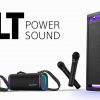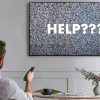Buying a TV is more than just looking at the ads, going online or to your local big-box retailer, grabbing a box, and paying the cashier. There is more to take into consideration.
Related reading:

Samsung & QD-OLED
When it comes to brands, Samsung Electronics is the world’s largest TV maker both in manufacturing and sales. However, their TV lineup is dominated by LCD-based choices.
One sticking point for Samsung is that its biggest competitor, LG, dominates the OLED TV market. Almost all OLED TVs available to consumers from Sony, Vizio, Panasonic, and other select brands, use OLED panels made by LG’s sister company LG Display.
China-based display panel makers have also put pressure on Samsung, as they are flooding the market with cheaper LCD panels which Samsung’s other competitors are buying up, causing big price drops in LCD TVs sold to consumers.
This has caused the Samsung Display Company (which has been the principal maker of LCD panels for Samsung TVs) to pull back from LCD panel production as it is no longer profitable, and plunge into developing alternatives that will make Samsung Display innovative, standing out from the rest as a TV panel maker. This resulted in the introduction of QD-OLED TVs in early 2022.
Tip: Samsung Display sometimes refers to QD-OLED TV tech as QD Display Tech.

What QD-OLED TV Tech Is
QD-OLED stands for Quantum Dot with Organic Light Emitting Diode
Quantum Dots: A quantum dot is a nanocrystal with semiconductor properties. When a quantum dot nanocrystal is hit with photons from a light source (in the case of QD-OLED TVs, light from a blue OLED panel) the dot emits the color of a specific bandwidth, which is determined by its size. Larger dots emit light that is skewed toward red. As the dots get smaller, the dots emit light that is skewed toward green.

The process of a quantum dot emitting red or green light after being struck by a blue light source is referred to as Quantum Dot Color Conversion (aka QDCC).
OLED: OLED stands for Organic Light Emitting Diode. Organic LEDs are self-emitting, meaning that when with provided electric current they produce their own light and color. In OLED TVs, they are used in place of an LED backlight and LCD panel, as they provide the necessary capability to display images without those extra internal components. In a QD-OLED TV, they are used slightly differently as the OLED panel functions both as a backlight for red and green color-sensitive quantum dots, as well as providing the blue color for screen display.

QD-OLED technology combines Quantum Dots with OLED and eliminates the need for an LCD panel to display images. A layer of OLEDs placed on the back of the TV emits blue light. The blue light strikes a layer of quantum dots to produce green and red light, while a portion of the blue light from the OLED layer passes through untouched to the screen. As mentioned, an LCD screen panel is not needed to display images – the blue OLED light and the green and red light Quantum Dot light produce the displayed screen images.
Tip: To compensate for an inherent problem with blue OLED pixel degradation, QD-OLED panels incorporate at least 3 layers of blue OLED pixels. Just with OLED, no LCD panel is needed for the display image. Similar to OLED, QD-OLED technology supports the ability to display absolute black in addition to more precise color than OLED.

QD-OLED as a Transitional Technology
QD-OLED has been very well received since its release in early 2022, but there is a catch. It is seen by its prime mover, Samsung, as a short-term advancement to stay ahead of both OLED and LCD-based TV competition.
Looking forward, to eliminate any possible issues with using blue OLED panels, Samsung is looking into Quantum Dot Nanorod LEDs (similar to micro LEDs) as a replacement. In this scenario, instead of using an organic Blue-OLED backing layer, Non-organic Quantum Nano Emitting Diodes would be used to produce the necessary blue light source – with quantum dots doing the green and red color conversion as they do in QD-OLED. The working moniker for this solution is QNED (not to be confused with LG’s LCD-based QNED miniLED TVs).

The advantage of Samsung’s proposed version of “QNED” over QD-OLED is that nanorods are inorganic which provides a longer-lasting stable blue light source. However, this solution is still in the early development stage and probably won’t be available until 2024 or 2025.
Samsung sees QD-OLED as a transitional TV technology to stay ahead of its competition by offering something different than OLED or LCD-based TVs until QNED TV is ready. However, for savvy consumers, why buy a QD-OLED TV in 2022 if QNED is going to become available a couple of years later? On the other hand, if the 2024/2025 target date for QNED gets pushed back to 2026 or later, then Samsung may have made a good decision regarding QD-OLED.
As of 2022, Samsung Electronics and Sony Electronics are the only two TV makers marketing QD-OLED TVs and they are only available in 55 and 65-inch screen sizes. If successful, more screen sizes may be on the way for 2023 and more brands may join the market in 2023 or 2024.
Tip: One thing that is confusing is that Samsung is marketing QD-OLED sets as OLED TVs, rather than QD-OLED or QD Display TVs.
Price & Availability
Samsung

2022 MODELS
QN55S95B (55-inch)
- $1,499.99 or less at Amazon, Samsung, Crutchfield
- $2,299.99 or less at Amazon.ca, Samsung.ca
QN65S95B (65-inch)
- $1,899.99 or less at Amazon, Samsung, Crutchfield
- $2,799.99 or less at Amazon.ca, Samsung.ca
2023 MODELS
- QN77S95C (77-inches): $4,499.99 or less at Samsung.com, Amazon, Crutchfield
- QN65S95C (65-inches): $3,299.99 or less at Samsung.com, Crutchfield
- QN55S95C (55-inches): $2,499.99 or less at Samsung.com, Crutchfield
- QN77S90C (77-inches): $3,599.99 or less at Samsung.com
- QN65S90C (65-inches): $2,599.99 or less at Samsung.com, Crutchfield
- QN55S90C (55-inches): $1,899.99 or less at Samsung.com, Crutchfield
Sony

XR-55A95K (55-inch)
- $2,999.99 or less at Amazon | Sony | Crutchfield
- $3,999.99 or less at Amazon.ca | Sony.ca
XR-65A95K (65-inch)
- $3,999.99 or less at Amazon | Sony | Crutchfield
- $4,599.99 or less at Amazon.ca | Sony.ca
Related Reading
Buying A New TV: Everything You Need To Know
Samsung QD-OLED (QD Display) TVs Are Coming In 2022 Signaling Change (Updated)
New Samsung QD-OLED TVs Are Delayed: The Reasons Are Frustrating (Updated)
CES 2022: Sony Bravia XR Master Series A95K QD-OLED TV Unveiled



















































